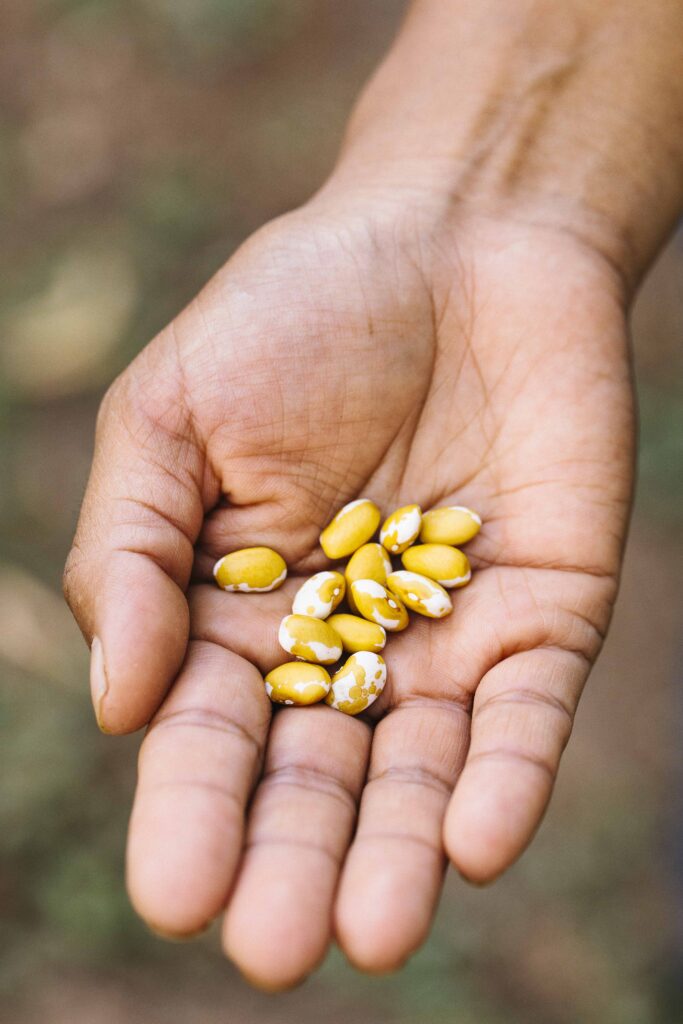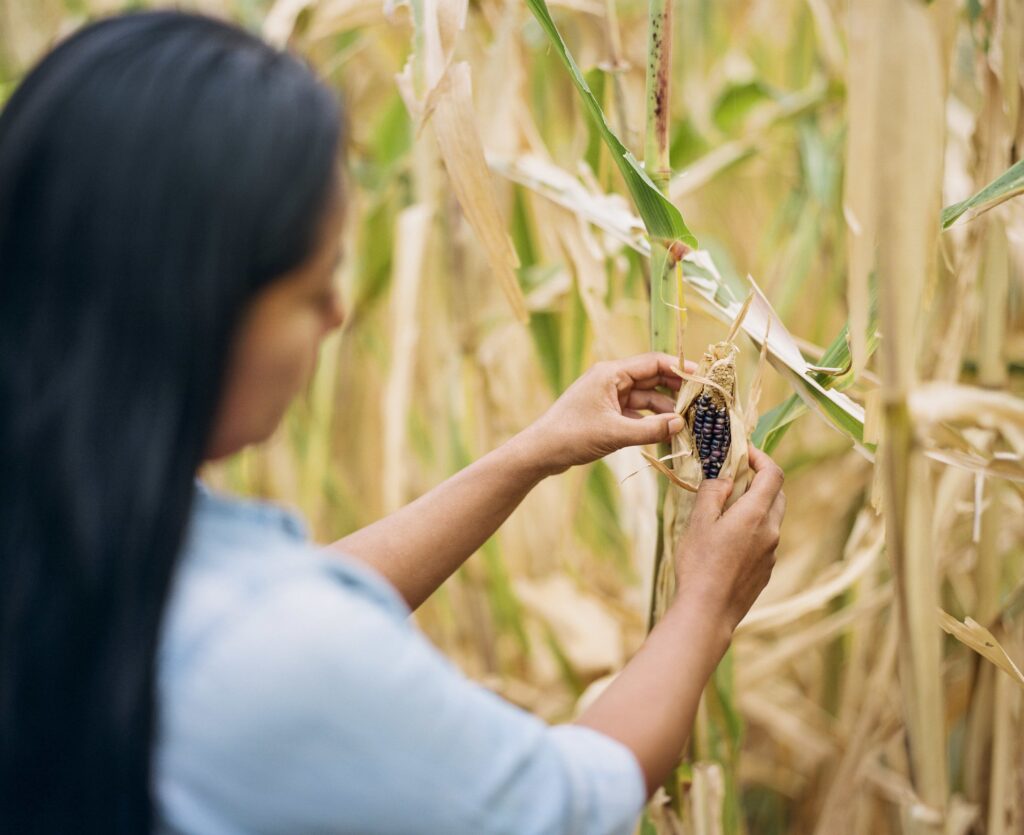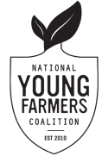Reyna Banteah is the owner and manager of Ts’uyya Farm, an Indigenous, woman-owned and operated farm in New Mexico’s Rio Grande Valley, in Albuquerque. Reyna is from Zuni Pueblo, home to the A:shiwi or Zuni people, one of the largest pueblos in New Mexico. She is also currently the Vice-President of the Rio Grande Farmers Coalition, a local chapter of the National Young Farmers Coalition.
Growing up, Reyna dreamt at different times of being a teacher, an environmental lawyer, and an environmental scientist, but farmer was never on the list until her senior year of high school. That was the first time agriculture was introduced to her as a career possibility rather than simply a low-paying job. She also participated in an internship at the Zuni Conservation Program that year that opened her eyes to the need in her own community. “That was the summer I realized how important and at the same time how agriculture was absent in my community,” Reyna explains.[1]
Reyna began to pursue farming with the goal of eventually bringing her skills and the food she grows to Zuni Pueblo. Like so many young farmers, however, finding secure access to land has been her primary obstacle.
Getting Started

Reyna got her start farming in 2017 through a training program called Grow the Growers (GTG). This program is a part of Cultivate Bernalillo County, an initiative within the County’s Open Space Program that aims to strengthen the local food economy by providing aspiring farmers with access to land and training. Grow the Growers is funded by a mill levy, or property tax, and run on Open Space property. The County partners with Agri-Cultura Network, a statewide farmer co-op that manages the daily operations of the farm program.[2]
During their first year at GTG, participants work forty hours a week and are paid a stipend. After completing the initial year of training, graduates are invited to submit a proposal to take on a small incubator plots on the property.
Land access is the number of challenge young farmers across the country face and numerous incubator properties exist to try and address this barrier. A few programs, like Grow the Growers, receive public funding, but most programs are run by private non-profits and supported through fundraising. Incubators can take many different forms—some provide training and shared resources, such as tractors and infrastructure, alongside access to land, and others help farmers with marketing. While most are focused on short-term land access, a few are set up to allow farmers to stay as long as is needed.
Ts’uyya Farm
Reyna managed an approximately quarter-acre incubator plot at GTG for two seasons and established her business, Ts’uyya Farm, there. Ts’uyya is the Zuni word for hummingbird, an important pollinator in the southwest. While at the incubator, she met Casey Holland, who was managing Red Tractor Farm at the time and participating in GTG as a trainer. Reyna learned a lot from Casey and the two became friends.
In 2018, Casey started managing her own business at Chispas Farm on four acres of land in the South Valley of Albuquerque. The land where Chispas Farm is located is owned by a philanthropist who provides Casey and the other farmers there housing and space to grow for free.[3] In 2020, Reyna was looking for a new home for Ts’uyya Farm. She connected with Casey and now works at Chispas part-time while operating Ts’uyya Farm out of a small (less than quarter-acre) plot of land on the property.
Chispas farm is one of the founding members of the Better Together CSA, an initiative started along with several other farmers and members of the Rio Grande Farmers Coalition in response to the COVID-19 pandemic. The CSA began by offering a four-week pilot project in the spring of 2020 with produce from seven participating farms, with the option to add eggs, pickles, jam, bread, and beef from other local producers. The CSA has since added more participating farms, provided weekly produce to 90 families during the growing season. Read more about their story here.
New Directions
Due to the move and COVID-19, Reyna scaled back her growing in 2020, focusing on a small amount of tomatoes and ramping up her perennial herb production. When she’s not farming, however, Reyna has been focusing on a new food business initiative—chocolate.
She started working at a bean to bar chocolate shop in Sante Fe in 2019 and completed the Three Sisters Kitchen training program this year. Reyna is now working on sourcing cacao beans from an indigenous farmer in Belize to make her bars, which include seasonal ingredients such as dehydrated raspberries. For now, she is making small batches of chocolate by hand while she saves up for the necessary equipment to expand production.
Indigenous growing practices build climate resiliency

On her small plot of land at the incubator, Reyna melded traditional farming practices with more modern technologies, incorporating three distinct watering techniques and growing a wide variety of heritage vegetables, herbs, and pollinator flowers, which she sold at local growers’ markets, restaurants, a few wholesale accounts, and a small CSA. Her focus was on growing landrace crops, such as beans, corn, squash, chile, amaranth, and gourds, and serving as a resource for local seed. Landrace refers to a species of plant or animal that is locally-adapted and has developed over time to its environment.
“I have been trying to keep southwest heat-tolerant and drought-tolerant varieties alive, and seek out seeds that I hope will survive a changing climate.”
“Back home [on Zuni Pueblo] we still depend on the monsoon rains to come and water our crops,” Reyna explains. “But now when weather patterns are not as consistent, you can’t tell what will happen in any given year.” During the 2019 season, for example, New Mexico had a lot of moisture in the winter and spring followed by months of drought without the usual late summer monsoon rains.
At the incubator, Reyna used multiple irrigation techniques to adapt. The majority of her market veggies were on drip irrigation, while she watered her waffle garden by hand using a dipper gourd. “The waffle garden is where I plant[ed] more of my heirloom drought tolerant varieties,” Reyna explained. “In another area, I use[d] flood irrigation, which is water diverted from the acequia and then onto the field.”
When asked about how she learned to build waffle gardens she said, “Growing up I didn’t see farming happening in waffle gardens, I just kept hearing stories and seeing photos from before my time. I didn’t even know how to build them, much less how to grow food in them. So, I did research with the museum and went to my elders to ask what they remembered. My aunties and grandparents taught me, and I knew this was something that I wanted to keep alive on my own farm and keep teaching to other people.”
Reyna hopes that learning these drought-resilient watering practices while growing in Albuquerque will someday allow her to cultivate food in Zuni, where water is incredibly scarce. “Our lake is dried up, the river is dried up, even our community wells are shutting down for weeks at a time to replenish,” Reyna says.
Sharing knowledge
At the start of each growing season at the incubator, Reyna hosted community workdays at Ts’uyya to share this knowledge and continue the tradition of building waffle gardens in the southwest. She has also hosted multiple cooking classes, as well as weekly yoga sessions, aiming to bring together a diverse range of people to connect with their food source in a more meaningful way.
Reyna is particularly focused on engaging youth and emerging young farmers. Though she is currently farming in Albuquerque, she regularly drives the two and a half hours to Zuni to bring fresh produce back home and to host pop up farmstands on the pueblo. Eventually, Reyna plans to move back home and root herself even more deeply in the agricultural community there.
Finding Secure Land
Finding secure, affordable land access is the top challenge facing young farmers across the country. While incubators may present a good opportunity for aspiring farmers who want to try out farming before looking for a place of their own, they tend to be set up in areas where land prices are particularly exorbitant or development makes land access unobtainable to new growers.
Although incubators are responding to an important need, getting started at one often means that in practice a farmer may spend a few years honing their skills and building their customer base around that location only to have to start over once they leave because they can’t access land in the surrounding area. Some incubators address this by reducing or removing limits on how long farmers can stay, helping departing farmers connect with land access opportunities, and continuing to allow farmers who are transitioning to new properties to access infrastructure, such as greenhouses, to start crops for the coming year.
Reyna comments that in Albuquerque she sees a lot of gentrification occurring in places that were once sacred space for agriculture. She would like to see people who are of the land and who are connected to the land afforded some protections against larger entities that are coming in, buying land, and selling it at prices that can only be afforded by the wealthy.
Reyna describes her ideal land access situation as somewhere between an acre and three acres of land with access to a permanent source of water. She would also need infrastructure, such as cold storage, a wash station a greenhouse, high tunnels, and storage space. Healthy soil is important to her and she would like to have the long-term security to incorporate perennial, orchard, and wild spaces. At the moment, she is interested in remaining in Albuquerque, although her goal is to eventually farm in Zuni.
Zuni Pueblo, located 150 miles west of Albuquerque, encompasses approximately 450,000 acres of land and is home to more than 7,000 people. The Zuni people have lived in the American Southwest for thousands of years and have cultural and religious traditions that are rooted in deep connections to the mountains, river ways, forests, and deserts.[4]
Transitioning to farming in Zuni would be challenging for Reyna because most Zuni land is traditionally family-owned and passed down through generations, but no one in Reyna’s immediate family owns land. Securing funding to start her business is also a challenge. “Being an Indigenous female farmer automatically gives me a disadvantage in terms of accessing capital because resources are often given to those individuals who are most likely to succeed in terms of economic growth and stability,” Reyna explains. “Coming from a small, monetary challenged community it is harder to seek investors who are willing to help you get funding to access larger costs, such as owning land, leasing, or even starting a business.” Aside from the environmental factors such as securing a reliable water supply, acquiring land is the first step in teaching and feeding her community closer to home.
Indigenous Land Loss
Current land access challenges, particularly for Indigenous growers, can be linked to a long history of colonization and land dispossession. Prior to European settlement, Indigenous people stewarded all of the land in what would become the U.S. and engaged in robust agricultural and economic activity. According to the 2017 USDA Census, Indigenous people now make up less than 2 percent of farmers and own less than 6 percent of farmland.[5] This land loss occurred disproportionately on high-quality land.[6]
The majority of the current land base in this country was acquired by the federal government through a combination of violent taking, purchase, cession, and treaties between 1781 and 1867, and subsequently granted or sold to states, corporations, and individuals.
In total, the government has been directly responsible for the redistribution of more than 1.5 billion acres of Indigenous land through specific policies, such as the Homestead Acts and General Allotment Act of 1887, along with Supreme Court cases, declarations of war, and the use of violence. In many cases, such as with 65 million acres of wetlands given to states and another 288 million acres of land granted directly to homesteaders, allocations were predicated on the recipient “settling upon and improving” the land for agriculture.[7] Read more on the Indian Land Tenure Foundation site and see a mapping resource here.
Organizations Supporting Indigenous Land Access
A number of organizations around the country are working to cultivate community focused on issues of land access for Indigenous people. A few examples include:
- Indian Land Tenure Foundation
- Indigenous Food and Agriculture Initiative
- Intertribal Agriculture Council
- Sogorea Te Land Trust (CA)
- Amah Mutsun Land Trust (CA)
- The Cultural Conservancy (CA)
- Minnow (CA)
- Northeast Farmers of Color Land Trust
- Native Land Conservancy (MA)
- New Mexico Acequia Association – Los Sembradores training program in Northern New Mexico
Additional resources on Indigenous farming recommended by Reyna:[8]
- Rowen White, director and founder of Sierra Seeds and a Seed Keeper from the Mohawk community of Akwesasne
- Permaculture Skills Center to learn more about regenerative land design
- Traditional Native American Farmers Association whose mission is to revitalize traditional agriculture for spiritual and human needs, by creating awareness and support for Native environmental issues
- Hopi Tutskwa Permaculture, a community Indigenous-led non-profit based in the Village of Kykotsmovi, located in Northern Arizona on the Indigenous Hopi Reservation.
Incubator Resources
Helping young growers find affordable, secure land is a complex issue that requires action at all levels of government, and local elected officials have an incredibly important role to play.
Although still relatively rare, an increasing number of programs like Grow the Growers that use public funding to help farmers access land are springing up around the country. More municipalities should consider what resources and potential funding sources are available to help address the land-related challenges farmers face in their region. In particular, programs should focus on supporting climate resilient farming strategies, Indigenous land access, and long-term security for growers.
Below are a few examples of publicly-funded land access programs around the country:
- Urban Edge Farm – Providence, Rhode Island (state + local non-profit partnership). This 50-acre parcel is owned by the State of Rhode Island and managed by Southside Community Land Trust, which has a long-term lease to the land. The land trust subsequently subleases to various farmers with plots ranging from ½ acre to 2 acres.
- Johnson County Historic Poor Farm – Johnson County, Iowa (county + local non-profit partnership). This county program is located on 10 acres of land and managed by staff from Grow: Johnson County, which is part of Iowa Valley Resource Conservation & Development. The county is supplying equipment for the project as well as building a shared wash and pack station. Farmers have a lease with the county and can rent in eighth of an acre increments. Grow Johnson County is also cultivating five acres of land to donate to hunger-relief agencies.
- Headwaters Incubator Farm – Orient, Oregon (county). East Multnomah Soil & Water Conservation District has run this five-year incubator program, which is funded through a property tax, since 2013. Any special use district in Oregon has the ability to levy taxes. In 2019, the program provided land access to close to 15 businesses and 20 farmers.
- The Seed Farm – Lehigh County, Pennsylvania (county). The county used its own funds combined with a federal grant through the USDA’s Beginning Farmer and Rancher Development Program to launch this three-year apprenticeship program.
- Good Hope Farm – Cary, North Carolina (town + non-profit partnership). The town of Cary purchased a farm property in 2008 with the goal of keeping it in agricultural production. Four non-profits came together to bring the farm incubator project to light. The Piedmont Conservation Council holds an eight-year lease with the Town and employees a farm manager. The Conservation Fund, North Carolina Community Development Initiative, and Conservation Trust for North Carolina support the project with funding and collaboratively they employee one project manager to handle grant writing, marketing, and other big picture duties. The Town of Cary provides a project manager who handles infrastructure installation, renovations, Town programs and services at the facility.
[1] https://tsuyyafarmblog.blogspot.com/2020/09/my-path-to-ag.html
[2] https://www.abqjournal.com/1229770/living-off-the-land.html
[3] https://alibi.com/food/55542/Casey-Holland-of-Chispas-Farms.html
[4] http://www.ashiwi.org/index.html
[5] USDA National Agricultural Statistics Service (NASS), 2017 Census of Agriculture, “Table 52. Selected Operator Characteristics,” 2019, complete data available at www.nass.usda.gov/AgCensus.
[6] Bryan Leonard, Dominic Parker, and Terry Anderson, “Land Quality, Land Rights, and Indigenous Poverty,” Journal of Economic Development, Volume 143, March 2020.
[7] Rebecca B. Bateman, “Talking with the Plow: Agricultural Policy and Indian Farming in the Canadian and U.S. Prairies,” The Canadian Journal of Native Studies XVI, 2(1996):211-228.
[8] https://www.teva.com/blog?postid=abigail-lafleur-and-reyna-tsuyya-farm
Photos: Stella Kalinina
